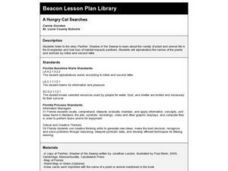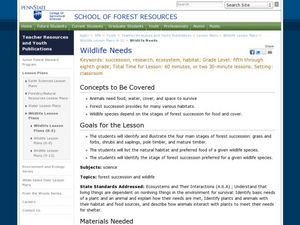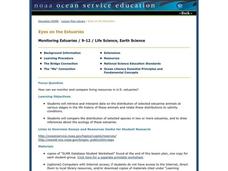Curated OER
Cypress/Tupelo Swamps
Young scholars study the geologic history of terrain, soils, and drainage patterns. They recognize ecological processes that determine the dynamic nature of habitats. They investigate the influence of human activity on the landscape.
Curated OER
Have to Have a Habitat
Learners create a zoological and botanical garden made up of a variety of species from around the world.
Curated OER
Mangrove Ecology & Adaptations
Learners creat a plant, animal, or other living organism that would be well adapted to a habitat that they previously selected. First they learn about adaptations of Mangroves.
Curated OER
My Owl Babies Miss Momma
Students investigate the relationship between children and parents by reading a book about owls. In this story analysis lesson plan, students read the book Owl Babies and participate in a role play based on one of the characters....
Curated OER
Striking a Balance
Students simulate animals in a food chain. In this food chain lesson plan, students are identified as grasshoppers, frogs or hawks. Popcorn is spread across a lawn and students are given baggies (stomachs) and colored sashes to identify...
Curated OER
A Hungry Cat Searches
Students listen to story Panther: Shadow of the Swamp, and examine how loss of habitat impacts panthers in the Everglades; students alphabetize names of plants and animals found in the Everglades by initial and second letter.
Curated OER
Issues And Decisions 4
For this environment worksheet, students read a passage on why alien species should be introduced to ecosystems. Then they respond to four questions that refer to the passage read. Students also respond to two decision questions by...
Curated OER
Illnois River and Lake Mussel Habitat Diorama Activity
Students identify the environmental elements of river and lake mussels. They compare the elements to the time before settlement and during industrialization. They also participate in a field trip to a mussel exhibit.
Curated OER
Lake and Pond Study
Learners examine the habitat and community structure of a pond that could support Ospreys through games and worksheets. They then go on a field trip to a pond to evaluate the suitability of the pond as an Osprey habitat.
Curated OER
Wildlife Needs
Students identify the wildlife needs in a specific setting. For this wildlife needs lesson, students identify and illustrate the four stages of forest succession. Students list the natural habitat and food for a given species. Students...
Curated OER
What's In The Forest?
Students examine forest food chains and create a forest habitat in the classroom. They are introduced to the concept of interdependence in Nature. They define a simple forest food chain and develop inquiry process skills.
Curated OER
Plants and Animals of Great Bay Animals and Plants of the Estuary
Students participate in a webquest about the plants and animals that inhabit an estuary. They role play as environmentalists researching this habitat and present the results of their research in a creative way.
Curated OER
Eyes on the Estuaries
Students study estuaries and compare several ones in the U.S. In this estuary lesson students interpret data and compare the distribution of different species.
Curated OER
Natural Inquirer
Students interview wildlife experts to gain information needed to research and write a report about an aquatic plant or animal affected by climate change.
Curated OER
Gale's Curriculum
Seventh graders develop an understanding of Southeastern Asian culture. They increase knowledge of world geography in relation to Southeast Asian countries. Students research a variety of Southeast Asian animals and habitats to be used...
Curated OER
More Than a Campground
Fourth graders participate in a class disucssion on the term "habitat". The class brainstorms on what makes a national park special. In small groups, they research a a national park and create a mural depicting those factors that make...
Curated OER
Big Fleas Have Little Fleas!
Students study seamounts and learn the importance of structures to species. In this ocean explorer lesson, students participate in an activity that teaches them how to modify a seamount so that they are more suitable for species.
Curated OER
Food Chains
Students investigate how food chains work. In this food chains lesson, students construct a food web for a pear tree habitat. The interactive whiteboard is an optional tool in this lesson.
Curated OER
Make Way for Wild Migrants
Students discuss the threats facing migratory species and track the seasonal journeys of wildlife in real space and in cyberspace. Once they have gathered information from several sources, they create a portfolio to share with others...
Curated OER
Critters of the Water
Young scholars examine different organisms in various marine habitats. They identify any adaptations that have allowed the organisms to survive. They develop an imaginary organism and describe its life cycle.
Curated OER
Grounded for Life
Second graders become familiar with the lives of penguins including their life cycles, habitats and basic needs. Students will experience the lives of penguins through stories and video.
Curated OER
Awesome Animals
Students collect data from classmates about their favorite animal. They use the ClarisWorks graphing program to enter data, graph results, and interpret data.
Curated OER
Biome Detective Sheet
In this biomes worksheet, students research the plant and animal life found in different habitats. This worksheet has 38 short answer questions.
Curated OER
Goals of the Diversity of Life Unit
Students are introduced to the unit on the importance of diversity of life and the role that interdependence plays in our worlds. this is part of a multi-lesson unit on the diversity of life.

























